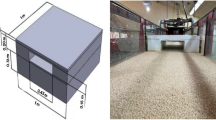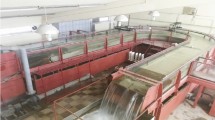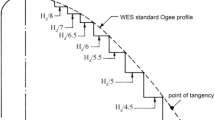Abstract
Energy control in high-speed flows is one of the main design challenges of hydraulic structures and drainage systems. Excessive flow energy can cause serious damages to these structures and may also lead to erosion and scouring at the downstream. Energy dissipation in such situation is usually accomplished by stilling basins, stepped spillways, or plunging jets. Using natural bed roughness to increase energy dissipation and reduce structural damage is more accessible in terms of implementation and significant reduction in construction costs. The present study is based on this phenomenon and was inspired by the Doroudzan dam spillway with a natural bed in Fars province of Iran. Application of obstacles or roughness on the bed of chute spillways can also be considered as an alternative for energy dissipation. In this study, the effect of bed roughness on flow domain and its dissipation of kinetic energy over chute has been experimentally investigated. For this purpose, several experiments on physical models were conducted with different geometrical and hydraulic conditions to determine their effects on flow over rough spillways. Experiments were performed with three slopes (15°, 22.5° and 30°), five uniform beds granulate roughness (5.1, 7.2, 11.1, 16 and 22 mm), and three discharges. The flow results over smooth spillway (made of Plexiglas) were also examined to compare the result. It was observed that bed roughness intensifies energy dissipation, modifies velocity and pressure domain, and eliminates cavitation tendency along the chute. The study proposes the advantage of natural bedrock as the spillway boundaries without concrete finishing. This idea offers environmentally friendly and cost-effective advantages with the benefit of enhanced energy dissipation and reduction in cavitation potential along chute spillways.















Similar content being viewed by others
Change history
28 March 2023
A Correction to this paper has been published: https://doi.org/10.1007/s40996-023-01095-w
References
Abbaspour A, Shiravani P, HosseinzadehDalir A (2021) Experimental study of the energy dissipation on rough ramps. ISH Journal of Hydraulic Engineering 27(sup1):334–342
Ahmad Z, Srisvastava D (2014) Energy dissipation on block ramps with large scale roughness. ISHS 2014-hydraulic structures and society-engineering challenges and extremes: Proceedings of the 5th IAHR international symposium on hydraulic structures
Azamathulla H, Ghani A, Zakaria NA (2009) Civil Engineers water management 162 december 2009 issue WM6. Sat 2(57):47
Boes RM, Hager WH (2003) Two-phase flow characteristics of stepped spillways. J Hydraul Eng 129(9):661–670
Chanson H (2002) Hydraulics of stepped chutes and spillways. CRC Press
Chatila JG, Jurdi BR (2004) Stepped spillway as an energy dissipater. Can Water Resources J/revue Canadienne Des Ressources Hydriques 29(3):147–158
Chen Q, Dai G, Liu H (2002) Volume of fluid model for turbulence numerical simulation of stepped spillway overflow. J Hydraul Eng 128(7):683–688
Christodoulou GC (1993) Energy dissipation on stepped spillways. J Hydraul Eng 119(5):644–650
Daneshfaraz R, Ghaderi A, Akhtari A, Di Francesco S (2020) On the effect of block roughness in ogee spillways with flip buckets. Fluids 5(4):182
Dehdar-Behbahani S, Parsaie A (2016) Numerical modeling of flow pattern in dam spillway’s guide wall. Case study: Balaroud dam, Iran. Alexandria Eng J 55(1):467–473
Eisenhauer N (1987) Location of aerators in spillways. Concr Int 9(3):62–66
Elnikhely E (2017) Investigation and analysis of scour downstream of a spillway. Ain Shams Eng J 2017(9):2275–2282
Falvey H (1982) Predicting cavitation in tunnel spillways. Water Power Dam Construct 34(8):13–15
Falvey HT (1990) Cavitation in chutes and spillways. Engineering Monograph 42. Water Resources Technical Publication. US Printing Office. Bureau of Reclamation. Denver.
Felder S, Severi A (2016) Entrapped air in high-velocity free-surface flows on a flat-sloped spillway. In: Proceedings of 20th Australasian fluid mechanics conference, Perth, WA
Fiedler W (2016) Managing dam safety risks related to hydraulic structures
French RH, French RH (1985) Open-channel hydraulics. McGraw-Hill New York
Frizell KW, Renna FM, Matos J (2013) Cavitation potential of flow on stepped spillways. J Hydraul Eng 139(6):630–636
Gemici Z, Koca A, Kaya K (2017) Predicting the numerical and experimental open-channel flow resistance of corrugated steep circular drainage pipes. J Pipeline Syst Eng Practice 8(3):04017004
Kaya N, Emiroglu ME (2010) Study of oxygen transfer e_ciency at ba_ed chutes. Presented meet. Proc Inst Civ Eng Water Manag 163:447–456
Kells JA, Smith C (1991) Reduction of cavitation on spillways by induced air entrainment. Can J Civ Eng 18(3):358–377
Khatsuria RM (2004) Hydraulics of spillways and energy dissipators. CRC Press
Lesleighter E (1988) Cavitation in hydraulic structures. Proc Int Symp n Model Prototype Correlation of Hydraulic Struct
Oertel M, Schlenkhoff A (2012) Crossbar block ramps: flow regimes, energy dissipation, friction factors, and drag forces. J Hydraul Eng 138(5):440–448
Pagliara S, Chiavaccini P (2006) Flow resistance of rock chutes with protruding boulders. J Hydraul Eng 132(6):545–552
Pagliara S, Carnacina I, Palermo M (2009) Energy dissipation in presence of block ramps with enlarged stilling basin. 33rd IAHR Congress
Pagliara S, Roshni T, Palermo M (2015) Energy dissipation over large-scale roughness for both transition and uniform flow conditions 2015:341–346
Parsaie A, Haghiabi AH, Saneie M, Torabi H (2016) Prediction of energy dissipation on the stepped spillway using the multivariate adaptive regression splines. ISH J Hydraulic Eng 22(3):281–292
RahmanshahiZahabi M, ShafaiBejestan M (2012) Experimental investigation of the effect of chute bed roughness height on energy dissipation. Water Soil Sci 22(2):95–106
Rajaratnam N (1990) Skimming flow in stepped spillways. J Hydraul Eng 116(4):587–591
Rice CE, Kadavy KC (1996) Model study of a roller compacted concrete stepped spillway. J Hydraul Eng 122(6):292–297
Strickler, A. (1981). Contributions to the question of a velocity formula and roughness data for streams, channels and closed pipelines
Author information
Authors and Affiliations
Corresponding author
Ethics declarations
Conflict of interest
The authors declare that they have no competing interests.
Rights and permissions
Springer Nature or its licensor (e.g. a society or other partner) holds exclusive rights to this article under a publishing agreement with the author(s) or other rightsholder(s); author self-archiving of the accepted manuscript version of this article is solely governed by the terms of such publishing agreement and applicable law.
About this article
Cite this article
Hasanabadi, H.N., Kavianpour, M.R., Khosrojerdi, A. et al. Experimental Study of Natural Bed Roughness Effect on Hydraulic Condition and Energy Dissipation Over Chutes. Iran J Sci Technol Trans Civ Eng 47, 1709–1721 (2023). https://doi.org/10.1007/s40996-023-01060-7
Received:
Accepted:
Published:
Issue Date:
DOI: https://doi.org/10.1007/s40996-023-01060-7




